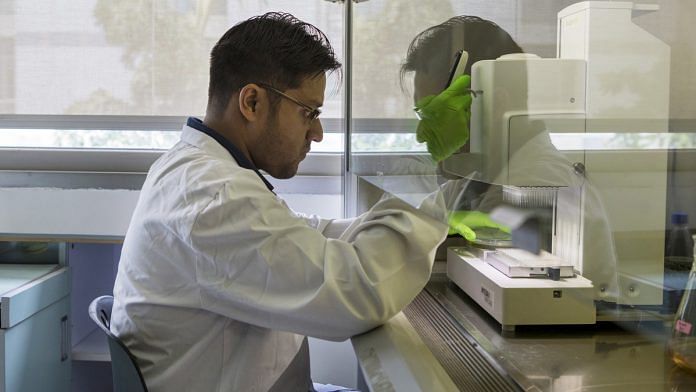According to a new report, India accounts for nearly three quarters of the total public funding on R&D by low- and middle-income countries.
New Delhi: India is leading developing countries in funding research & development (R&D) on cures and treatments for ‘neglected diseases’, a study has found.
According to the G-FINDER survey on neglected diseases, conducted by Australia-based think-tank Policy Cures and funded by the Bill and Melinda Gates Foundation, India accounts for nearly three quarters, or 75 per cent, of the total public funding on R&D by low- and middle-income countries.
India’s public funding on R&D for these diseases, the survey says, increased by Rs 135 crore between 2016 and 2017.
The organisation defines neglected diseases as those that predominantly affect developing countries “and for which products are needed but there is insufficient commercial incentive to stimulate R&D”.
These include HIV/AIDS, malaria, tuberculosis, dengue, and diarrhoeal diseases like cholera.
“In 2017, India was the fourth-largest funder by absolute funding and proportion of GDP and accounted for almost three-quarters (Rs 492 crore) of the public funding from low-income and middle-income countries,” said the report, which was released Wednesday.
The four top funding organisations from India include the Indian Council of Medical Research (ICMR), the Department of Biotechnology (DBT), the Biotechnology Industry Research Assistance Council, and the Council of Scientific and Industrial Research (CSIR).
Also read: India doesn’t have polio vaccine for the next round of immunisation
The familiar threats
Between 2016 and 2017, India’s funding for dengue R&D increased by Rs 11 crore, or 48 per cent. The ICMR, which increased its funding for dengue by 35 per cent, or Rs 6.5 crore, emerged as the third-largest funder for this disease globally.
Dengue, a flu-like illness known to turn fatal in the absence of proper treatment, is a recurring challenge for India, where thousands are infected by the disease every year. According to Ministry of Health & Family Welfare data, the number of cases went up from 99,913 in 2015 to 1.6 lakh in 2017, a rise of 58 per cent. In 2017, the disease reportedly killed over 300 people.
India increased its funding for tuberculosis by Rs 37 crore, or 34 per cent, between 2016 and 2017.
Eradicating tuberculosis (TB), an infectious disease that affects the lungs, has been a priority for India, which, according to the report, witnessed an estimated 2.74 million new cases in 2017 and accounts for one-third of all deaths from TB worldwide.
Last year, Prime Minister Narendra Modi said the country aimed at eliminating TB by 2025, which is five years before the global target of elimination by 2030.
Experts involved in TB treatment said the country’s efforts were showing results on the ground.
“I have worked on TB in our country for the last 25 years,” Dr Bobby Bhalotra, a pulmonologist at Delhi’s Sir Ganga Ram Hospital, told ThePrint.
“The programme on TB eradication is commendable. The access to free medication and follow-up programmes have made a big difference,” he added.
Also read: This new blue pill is stopping HIV like never before, study shows
‘Very serious’
Malaria, another vector-borne disease India has had a long struggle with, received a funding boost of Rs 43 crore between 2016 and 17, a rise of 59 per cent.
According to the World Health Organisation (WHO), India accounts for 89 per cent of all malaria cases in southeast Asia. According to the National Vector Borne Disease Control Programme (NVBDCP), in 2017, India recorded 8.4 lakh cases of malaria and 194 deaths.
For diarrhoeal diseases, India increased funding by Rs 12 crore, or 35 per cent, between 2016 and 2017.
According to United Nations data, India is one of five countries that together account for half the 1.3 million under-five children killed by diarrhoeal diseases every year.
“The scenario of what is called neglected diseases is very serious in India,” Dr Sanjeev Sinha, a professor at the AIIMS Department of Internal Medicine, told ThePrint.
“There is a huge burden of patients across the country… The need for research to stop transmission of a disease like malaria can only happen with effective research,” he added.
“We need to involve both public and private health experts in research of these diseases,” Sinha said.
He added that the increase in funding was encouraging, saying this segment should be made a priority in the Union Budget.
Long way to go
According to the survey, R&D on neglected diseases drew a global contribution of $3.5 billion in 2017, an increase of 7 per cent since 2016, driven primarily by new investments from the United Kingdom, Europe and India.
“It is very encouraging to note that investments in neglected disease R&D went up in 2017, especially from middle-income countries,” said WHO deputy director general Dr Soumya Swaminathan. “Millions continue to suffer and new tools are urgently needed.”
However, even as the report spelt some cheer with the greater funding figures, the overall expenditure still falls well short of global targets.
According to the survey, not a single country met the WHO recommendation that member states dedicate at least 0.01 per cent of their GDP to research the health needs of developing countries.
India’s contribution comes to 0.003 per cent of its GDP, according to the survey. The US was the closest in meeting the target, spending 82 per cent of the expected expenditure, while the UK came second with 71 per cent. All the others scored below 50 per cent of the target.
According to the report, the public sector continued to be the most significant funding source for neglected disease research, contributing nearly two-thirds of the total.



